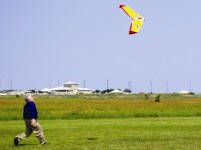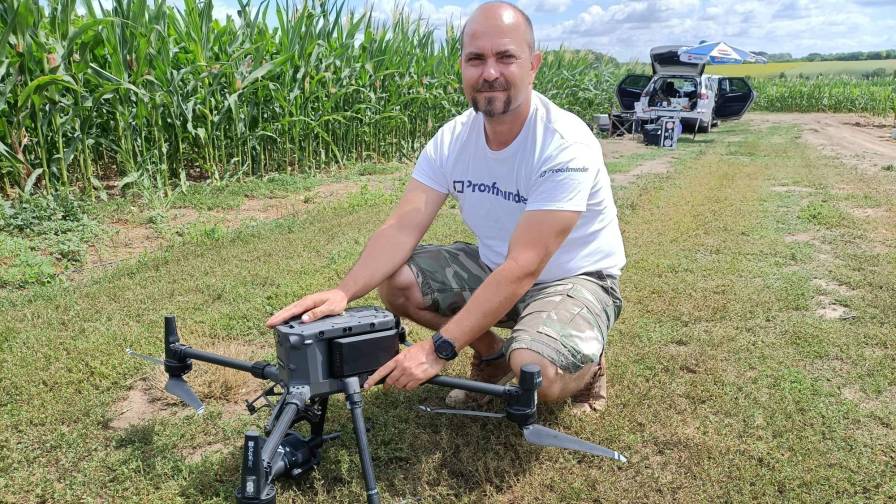Flight Plan For UAVs

More than 25,000 “field” or agriculture robots will be sold by 2015 — about the same as robots for military use, according to the International Federation of Robotics (IFR). Together, defense and agriculture make up the lion’s share of the nearly 94,000 “service robots for professional use” that the IFR believes will be sold in the next couple of years. Defense and agriculture are by far the two largest categories in IFR calculations, with robots for things like logistics, medicine and rescue coming in well behind.
IFR statistics for 2011 sales of “professional use” robots — as opposed to robots for the industrial sector — offer a snapshot of this market. Overall unit sales in 2011 were up 9% over 2010, with unmanned systems for armies around the world coming in at 6,570, or 40% of the total. Right behind were sales of unmanned systems for agriculture at 5,000 units, or 31%.
Going Commercial
While ground vehicles are dealing with their own sets of challenges in agriculture, companies that want to use robot aerial systems in this market face others. One big hurdle is approval by the Federal Aviation Administration (FAA). It’s now illegal to fly unmanned aerial systems for commercial purposes in U.S. airspace (UAS). Assuming the Federal Aviation Administration approves low-level, line-of-sight operations — like those applicable to the monitoring and spraying of crops, for instance — analysts expect the market to boom. An AUVSI report in March 2013 says that during the period 2015-25, integrating UAS into national airspace will contribute $82 billion to the U.S. economy — a whopping $75.6 billion of which will go directly to agriculture. Another $3.2 billion will boost the public safety sector, and the remaining $3.2 billion will go to the “other” category. More than 100,000 jobs would be created.
The 38-page report, “The Economic Impact of Unmanned Aircraft Systems Integration in the United States,” says unit sales of UAS will rocket from just under 40,000 in 2015 — when FAA is expected to give its approval — to about 160,000 by 2025. Even so, the study’s authors take what they say is a conservative approach, using “100,000 unit sales per year as a conservative benchmark.” One of the authors, Bijan Vasigh, a professor of transportation at Embry Riddle Aeronautical University in Daytona Beach, FL, says the numbers could be higher, or lower. “We are really projecting what will happen in a normal scenario. If the scenario is more conducive for [unmanned aircraft], the impact would be much stronger.” At the same time, unforeseen circumstances “could impede progress.”
Some aren’t sure how the FAA will rule, but Vasigh is optimistic. “Frankly, I don’t see that much problem with FAA. I’m a little bit positive on go ahead, especially at lower altitude.”
Optimism, with a bit of caution, is also expressed by Young Kim, general manager of BOSH Precision Agriculture, Newport News, VA. BOSH, which has been oriented to the military UAS market, is shifting its sights to UAS for agriculture because the market is big and steady — as opposed to defense, which is big but probably won’t be steady forever.
“As an entrepreneur, I’m an optimist,” Kim says. At the same time, he sees no large, single, organized group engaging the FAA. “If we can get the farmer, UAV vendors, universities, economic development people, ag trade organizations,” like state cotton and peanut commissions and citrus growers, all addressing the FAA with a unified voice on safety and certification and policy, possibly with AUVSI participation, success would be more certain.
Foreign Expertise
Japan is well ahead of the U.S. in the use of unmanned aerial systems for agriculture. In 1983, the Japanese government asked Yamaha to help it develop an unmanned helicopter for agricultural duties. The country was faced with an aging farming population and wanted to make things like spraying more efficient, according to Steve Markofski, a U.S.-based new business planner for the company. In 1991, he says, Yamaha began to market its first ag-oriented unmanned helo, the R50. Today, 2,150 Yamaha RMAX unmanned helos spray about 2.5 million acres a year in Japan, covering about 40% of the country’s rice paddies. The government backed the idea from the beginning, with the Japanese department of agriculture responsible for regulation.
Yamaha hopes to translate its success in Japan to the U.S. One area that it thinks is promising is spraying vineyards. Yamaha is testing the idea, under a certificate of authorization from the FAA, by flying over vineyards in Napa, CA. They’re about the same size as rice paddies in Japan, five acres or so, and therefore a good match to the RMAX’s four-gallon chemical payload capacity, Markofski says. Tractors, traditionally used in Napa vineyards, can spray about two acres an hour, but RMAX can do 12 to 15 acres an hour. And with RMAX, Markofski says, there’s no soil compaction, no crop damage, the operator is not exposed to chemicals and it is safer, because he doesn’t have to drive in challenging terrain, like slippery hills. “We’re looking at areas [in the U.S.] that we think align directly to the RMAX, and vineyards is one that jumped out at us,” Markofski says.
Canada’s MicroPilot also is waiting for a green light from the FAA. The company, based in Winnipeg, Manitoba, is a leading manufacturer of UAS autopilots as well as the maker of CropCam, a camera-toting fixed-wing UAS that has made a name for itself in crop monitoring. CropCams have been sold in places like Kazakhstan, Southeast Asia and South America, but approval to fly in the U.S. would be a big boost, says Pierre R. Pepin, vice president of sales and marketing. He says one business model might be to work with those who sell pesticides, for example. They also could sell UAS services. A customer would therefore not only get a product from the seller, but also precise images of his crops.
“Once you’re allowed to fly,” Pepin says, “it doesn’t take a whole lot of imagination to see how you can use those little birds.”
University Research
While getting UAS to take off in ag is still on hold for the commercial market, a lot of research is currently going on at universities to see how unmanned aircraft could be a better imaging alternative for fields.
University of Florida’s Dr. Reza Ehsani is using smaller vertical takeoff and landing UAS to look for the citrus disease huanglongbing (HLB) in the state’s orange groves.
“We have used UAS for detecting HLB-infected citrus trees, and we showed that UAS can provide higher detection accuracy when compared with aerial images that were obtained with a manned airplane,” he says. “Images that we took with UAS had an accuracy of one-inch resolution compared to a 24-inch resolution that we got from aerial images obtained from a manned airplane. We think the higher resolution contributes significantly to higher accuracy of detecting the disease.”
Don Horneck, an extension agronomist professor from Oregon State University, recently teamed with Boeing to conduct a research project using unmanned aircraft systems to monitor potato crops.
“You can fly the UAVs low enough that you can get 1-mm resolution and you can actually look at an individual leaf in the field,” Horneck says.
With this kind of precision, researchers at Oregon State are examining potato crops by stressing the crop for nitrogen and water content. The examination aims to understand how quickly unmanned aircraft can detect deficiencies and other issues in the crops.
Kansas State University has a long list of research topics in ag, including precision agriculture, detection of insect damage, detection of herbicide overspray and mapping. But this summer, Mark Blanks, the school’s UAS program manager, is focusing his time on a new project he says he’s never seen done before — an economic impact comparison between using satellite imagery vs. UAS to monitor a large-scale farm operation.
“We’ll compare the traditional method of satellite data where they normally base decisions on — how to plant, how to fertilize, everything else — with satellite data. And we’ll do other fields using UAS and compare the two and see which one is more beneficial economically.”
The study will look at the entire growing season for the comparison, which stretches beyond press time. Blanks, says, however, “I fully expect us to be far more accurate.”
Blanks says despite a lot of chatter about agriculture with UAS outweighing the traditional alternative, he’s yet to see something as concrete as this study.
“It’s something I haven’t seen yet. I’ve seen a lot of projections about how it’s going to help farmers. And we know it’s good, but I haven’t seen any concrete economic research on it anyway saying, this is the savings, this is the benefit, this is why you should buy UAS,” he says. “We’ve seen a whole lot of anecdotal evidence, but not a lot of solid, thoroughly sound research.”
Read more articles on robotic agriculture.









